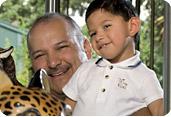The Sanchez Family
A Born Fighter

Laura and Jose Sanchez call their second son "Asa," a nickname derived from his older brother's inability to pronounce his given name, Alex. But Alex had an earlier nickname that came as the family watched him suffer through dozens of epileptic seizures that gripped his tiny body every day. Watching helplessly as he arched his back, locked his arms, and struggled just to breathe as yet another seizure began, they began calling Alex their "Little Warrior."
"I can tell you one thing about my son — he's a fighter," Laura says. "He's so full of life. He fought and fought to be where he is today."
A Surgical Solution
Alex is among the millions of Americans afflicted with epilepsy, a set of 70 disorders in which clusters of nerve cells in the brain may signal abnormally, causing seizures. Alex's seizures began within hours of his birth on March 17, 2004, caused by hemimegalencephaly, or abnormal growth of the entire left side of his brain.
Some cases of epilepsy are mild and easily controlled with medication. But Alex's epilepsy was intractable — it didn't respond to medication. Doctors at Texas Children's Hospital decided that surgery was the only way to save Alex's life. They removed the entire left side of his brain in a nine-hour surgery.
The surgery was a success. The few seizures that Alex continues to have were easily controlled by medication. Alex now has a bright future. His development will be close to normal, thanks to the human brain's remarkable ability — especially when young — to adapt. When he grows up, he will be able to live on his own.
Striving for Even Better Options
Still, Alex's outcome isn't perfect. Because of his surgery, he will always lack strength and dexterity on the right side of the body and will have limited vision from the right side of both eyes. So today doctors and researchers at the Jan and Dan Duncan Neurological Research Institute at Texas Children's Hospital are looking for better ways to treat epilepsy. The real hope is that one day, it will be possible to predict who will have epilepsy. Then doctors could correct the molecular abnormalities in the brain so epilepsy never develops — and children will no longer have to undergo Alex Sanchez's ordeal.
Among the investigators looking for new treatments is Gabriella D'Arcangelo, Ph.D., at The Gordon and Mary Cain Pediatric Neurology Research Foundation Laboratories at Texas Children's Hospital. D'Arcangelo and her team are looking for the underlying genetic defects that lead to one type of epilepsy. Once the genetic abnormalities are identified, the team will use genetic engineering to replicate the deficits in mice in order to test new therapies. According to D'Arcangelo, "We are well on our way to creating this model."
The Birthplace of Tomorrow's Treatments
These genetically altered animal models are vital to finding new treatments. But the first step of identifying the abnormal gene is not an easy task. The human genome contains 20-25,000 genes, and sifting through and interpreting them requires the cooperation of a team of researchers from a variety of disciplines, armed with the most advanced equipment available.
That's where the state-of-the-art facilities and collaborative environment of the NRI will play their part. Our core laboratories will contain highly specialized equipment and a breadth of expertise that provides researchers with an intellectual and technological infrastructure unmatched anywhere in the world.
The new facilities and additional researchers will speed the development of animal models, critical to testing many potential new therapies for stopping seizures and even preventing epilepsy. Someday children won't have to have epilepsy brain surgery. And families like Alex Sanchez's can look forward to an even brighter future.
Inspired by Alex's story? Make a donation now.


